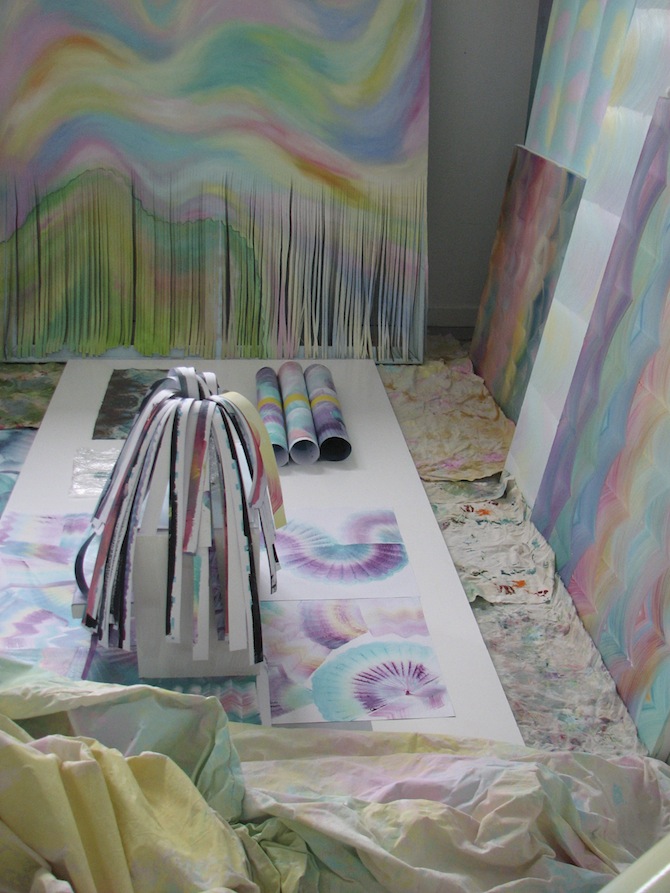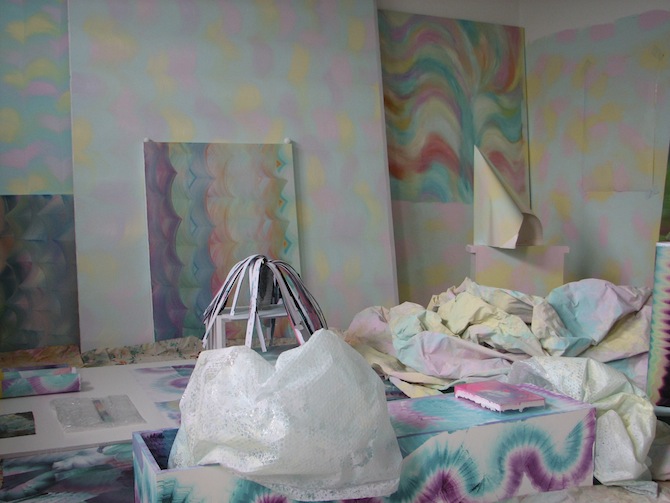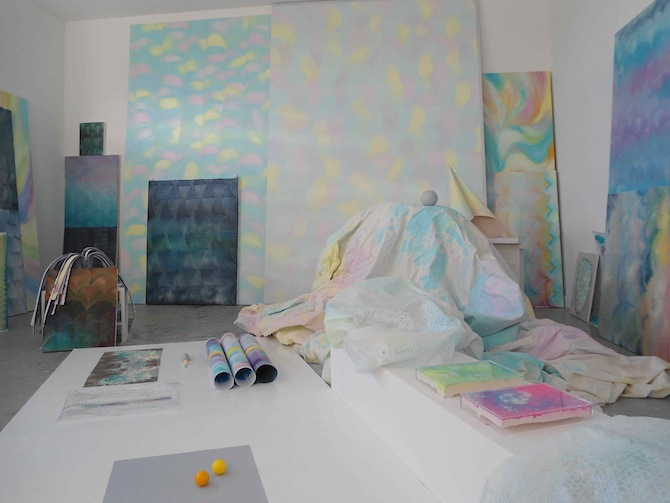
Studio Visit: Estonian artist Merike Estna in London
Jurriaan Benschop
21/06/2013
From central London it's a half hour train ride to Homerton, the district where Estonian born artist Merike Estna (1980) has her studio in the Matchmakers Wharf. The place derives its name from the Matchbox factory that used to be located here and produced the famous dinky toys. Now it's a residential area combined with artist studios. Estna came initially from Tallinn to London for a work period at Goldsmiths College. After finishing her Masters in 2009 she moved to Belgium for a year but then London called again and she made it her home base. The city offers a good context for her both critical and passionate exploration of painting.
For my visit Estna prepared a set-up of her work in her studio: It looks like a big installation consisting of different painterly elements. "When I'm actually painting it's hardly possible to have visitors," she says, since her work is conceived as an environment. It needs a kind of theatrical display. There are some pedestals on the floor, with different kinds of painted elements, like paper strips that are put together in a vase, as if they were flowers, and some painted bubble plastic, that usually is wrapped around paintings for shipping. Against the walls there are numerous canvases, partly leaning against each other, all with rhythmic patterns that are repeated all over the canvas in unlikely colour combinations as pink, blue and yellow. "Colours that I thought you couldn't make a painting with" Estna comments. All elements in the studio together create a painterly environment without a precise subject matter. Or the subject matter should precisely be this environment.
To paint without an image. That seems to be the challenge that Merike Estna took up some years ago. She knows this involves a paradox. Since the works that she finished create new images in the studio, even though they are abstract, and don't contain scenes or figures. Years ago the artist used to paint in a (half-) representational style, did landscapes and (abstract) expressionistic painting, with a high physical presence, through explicit gestures of painting. The gesture is still important in the new works. But now it produces a sequence, rather then being a trace of individual expression. "I got bored with the images", says Estna, if looking back to her earlier works, "but not with painting. At Goldsmiths I was one of the few painters, and the atmosphere was kind of hostile towards painting. That made me even more obsessed to do painting and find new ways."
An artist that is an inspiration for Estna is the German painter Katharina Grosse, who also practices an expansive and colourful kind of painting, that reaches beyond the borders of the canvas. Grosse paints for instance with an industrial spray gun on a whole building. Basically anything can be the support of paint, from a pile of dirt till sculptural elements. In Estna's case, the traditional rectangular canvas is still an important part of the work, but it is connected through other elements to the rest of the space. And the way of presenting the works breaks with the classic hanging of a single painting on the wall, waiting for special attention. In Estna's case a canvas can lean against an exhibition wall, or contain holes so a light behind it can shine through. The importance of the single image is reduced, one could say, in favour of a serial and environmental approach. But still it should be noted that every single canvas has a unique combination of pattern and colour.
"In Estonia painting is understood in a very traditional way," Estna comments, if I ask why she turned her back on the traditional canvas which for years was her reference. "There is a limited number of painters and an limited conception of what a painting could be. This was one of the reasons that I looked for other options, and other ways op presenting a painted surface. (...) The aim is to open it up. To create an open situation with the work, without final answers." It's not one story that she wants to transmit, rather possibilities. For instance she allows, and even encourages that her paintings are turned 90 degrees during an exhibition. Since there is not just one way of looking at them. This off course goes only for the pattern paintings, that don't have a hierarchy in terms of composition. In Estna's words it's about "the experience one has and the ways we think about and look at paintings."
During the studio visit I wonder if this 'painting without image', as Estna puts is, leaves a feeling of omission or if it triggers the imagination in a fulfilling way on another level. To decide about that I would need to see a real and completed exhibition and not just a set up in a studio, since Estna's way of working is all about grabbing the space and creating a parcours. The way the artist surrounds you as a viewer with paint is playful and original. It makes you want to look around and explore the different elements that are affected by paint. Also Estna's specific use of colour, both sweet and pale, is capturing. The question would be if it still makes sense to judge a single painting on it's merits in this approach, since painting has become part of a set, rather then being an isolated image.




